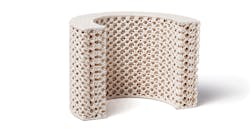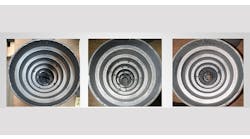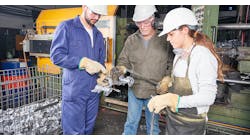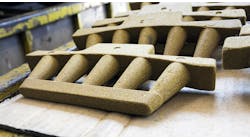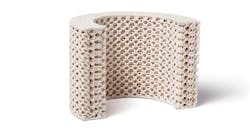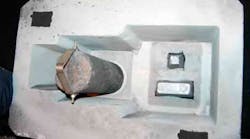Latest from Ask the Expert
For larger castings we use no-bake (PEP SET™) molding on a medium-sized loop line. Once made, these molds are moved to the pouring floor for hand pouring. For these no-bake castings the microstructure and mechanical properties are highly unpredictable and result in high scrap rates. Can you suggest a more reliable inoculation practice for these floor-molded castings?
A:The improved metallurgical quality of the casting poured in your green-sand operation can be directly attributed to the late (in-stream) inoculation practice. Adding a late inoculation step to the larger, hand-poured molds could improve the metallurgical quality of these castings. However, using in-stream inoculation might not be practical, so other methods will need to be considered.In recent years, increasing demands for improved mechanical properties and the challenges encountered by foundries trying to inoculate electric furnace iron have established a need for potent inoculation that is introduced just before the casting cavity is filled, i.e. late inoculation.
On your automatic molding line you have satisfied these demanding specifications by adopting late inoculation in the form of in-stream inoculation. In-stream inoculation is well suited to applications that involve pouring the casting in the same location each and every time. However, due to the need for specialized equipment, employing in-stream inoculation for hand-poured castings is not so easy.
Moving the ladle from mold to mold on the pouring floor is a challenge in any case. Now consider moving equipment along with the ladle, and it is clear that this can be a very time consuming and cumbersome process. Well, perhaps you could have a member of the pouring crew add a carefully metered, precise addition of sized material to the iron stream, during mold filling. That would be a solid solution except for the drawbacks: labor costs, safety concerns, and the likelihood that the feed-rate of the inoculant will be inconsistent are a few of the disadvantages of this practice.
So, let’s consider a more practical method for late inoculation of hand poured castings: using solid, cast ferrosilicon inserts in the mold (or pouring basin.) This technique is widely accepted as a viable method for late inoculation of hand poured castings. In fact, it is commonly used for all types of molding and pouring operations. Using solid cast inserts for your late inoculation of gray and ductile iron would provide these benefits:
• No fade. The inoculant goes into solution as close to solidification as possible.
• Proper addition rates. Solid cast inserts are produced in more than 15 different sizes, so providing the proper addition rate (0.1 – 0.2%) for your mold is not a problem.
• Uniform inoculation. The insert dissolves continuously during pouring, providing even, uniform inoculation.
• No slag generation. The inoculant goes into solution in the absence of atmosphere, resulting in very clean inoculation.
• Potent inoculation effect. These inserts are engineered to provide maximum effect for gray and ductile iron.
So, if you’re looking for a more reliable inoculation practice that will improve the metallurgical quality of castings, reduce variability, and save money by reducing scrap, consider late inoculation with solid cast inserts. GERMALLOY™ is recommended for ductile iron castings; OPTIGRAN™ is the choice for gray iron castings. Metallurgy experts at ASK Chemicals can provide recommendations for the proper sizing and application of mold inoculation for no-bake and green-sand operations.
Join the Conversation. Email Your Questions for ASK Chemicals
Share your insights, opinions, and elaborate on the questions and the experts' answer(s). You must be logged in to the website in order to post your comments.
